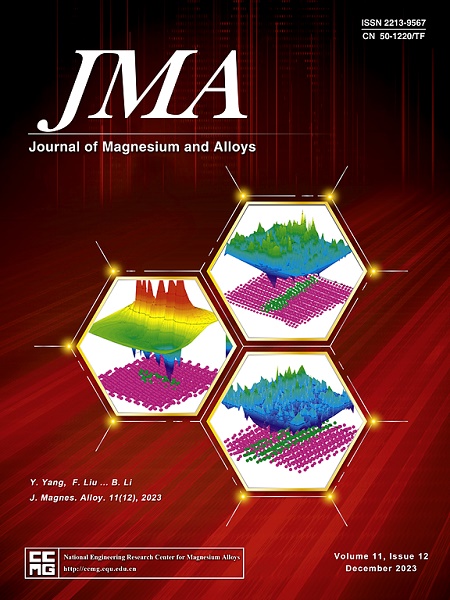在低合金Mg-Zn-Ca-Al-Mn合金中实现令人印象深刻的超塑性:晶界偏析和致密β-Mn颗粒的作用
IF 15.8
1区 材料科学
Q1 METALLURGY & METALLURGICAL ENGINEERING
引用次数: 0
摘要
实现令人印象深刻的超塑性是制造复杂形状镁合金产品的重要策略。在本研究中,我们报告了在 623 K 和 1.0 × 10-3 s-1 条件下,通过等通道角压制造的 Mg-1.51Zn-0.59Ca-0.59Al-0.70Mn(重量百分比,ZXAM2111)合金可以实现伸长率大于 500% 的优异超塑性变形。超塑性变形主要通过晶界滑动(GBS)进行,变形后晶粒尺寸从∼3.0 µm增长到∼6.0 µm。变形前,ZXAM2111 合金的主要特征是 Zn 原子和 Ca 原子在晶界强烈共聚,β-Mn 颗粒均匀分布。随着变形的进行,β-Mn 颗粒进一步沿着与拉伸轴平行的晶界动态析出,从而提高了抗晶粒粗化的能力。虽然增强的稳定效应降低了应变速率敏感值,但由此产生的令人印象深刻的微观结构稳定性为 GBS 的主动运行提供了基石,有助于实现超塑性变形。本研究可为开发具有高微观结构热稳定性的低合金镁合金以实现超塑性提供启示。本文章由计算机程序翻译,如有差异,请以英文原文为准。
Realizing impressive superplasticity in a low-alloyed Mg-Zn-Ca-Al-Mn alloy: The roles of grain boundary segregation and dense β-Mn particles
Achieving impressive superplasticity is an important strategy to manufacture Mg alloy products with complex shapes. In the present study, we report that an excellent superplastic deformation with elongation larger than 500% can be achieved at 623 K and 1.0 × 10−3 s−1 in a Mg-1.51Zn-0.59Ca-0.59Al-0.70Mn (wt.%, ZXAM2111) alloy fabricated by equal-channel angular pressing. The superplastic deformation is mainly carried by grain boundary sliding (GBS), accompanied by a grain size growth from ∼3.0 µm to ∼6.0 µm after deformation. Before deformation, the ZXAM2111 alloy is mainly characterized by a strong co-segregation of Zn and Ca atoms at grain boundaries and uniformly distributed β-Mn particles. With deformation proceeding, the β-Mn particles further dynamically precipitate along grain boundaries that parallel the tensile axis, leading to improved resistance to grain coarsening. Although the enhanced stabilizing effects decrease the strain rate sensitivity value, the resulting impressive microstructure stability provides a cornerstone of the active operation of GBS, facilitating the achievement of superplastic deformation. The present work could provide insight into developing low-alloyed Mg alloys with high microstructure thermal stability to achieve superplasticity.
求助全文
通过发布文献求助,成功后即可免费获取论文全文。
去求助
来源期刊

Journal of Magnesium and Alloys
Engineering-Mechanics of Materials
CiteScore
20.20
自引率
14.80%
发文量
52
审稿时长
59 days
期刊介绍:
The Journal of Magnesium and Alloys serves as a global platform for both theoretical and experimental studies in magnesium science and engineering. It welcomes submissions investigating various scientific and engineering factors impacting the metallurgy, processing, microstructure, properties, and applications of magnesium and alloys. The journal covers all aspects of magnesium and alloy research, including raw materials, alloy casting, extrusion and deformation, corrosion and surface treatment, joining and machining, simulation and modeling, microstructure evolution and mechanical properties, new alloy development, magnesium-based composites, bio-materials and energy materials, applications, and recycling.
 求助内容:
求助内容: 应助结果提醒方式:
应助结果提醒方式:


